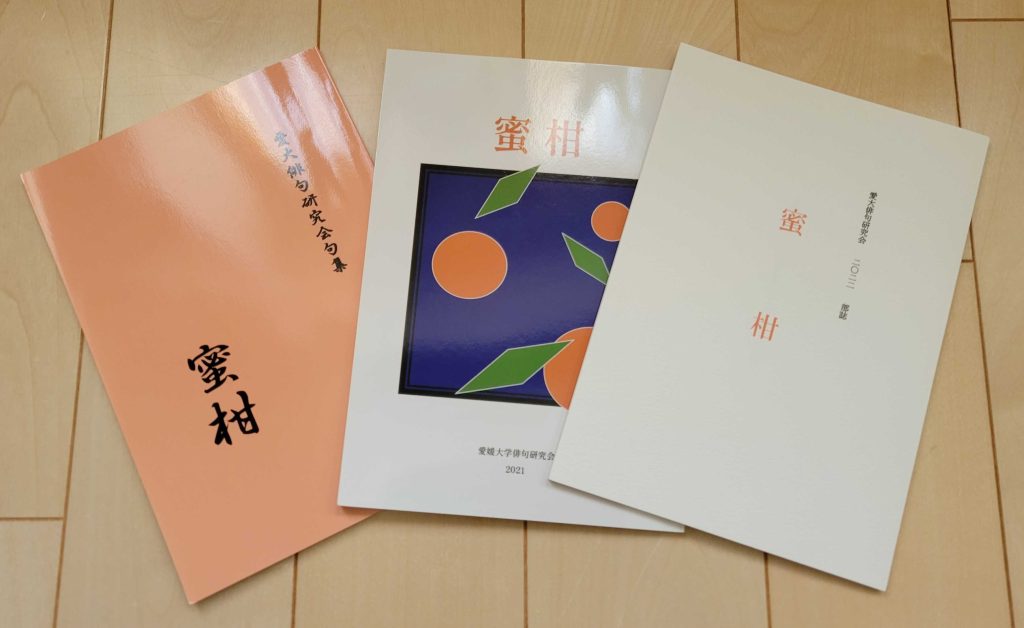Ehime University Haiku Study Group
Matsuyama’s unique circle ” Ehime University Haiku Study Group”
Why don’t we all write haiku together?

To those of you who think “Haiku is difficult.” Haiku is very fun to write. If you would like to know how to write a simple haiku, please refer to the bottom of this page.
One of the most enjoyable ways to enjoy haiku is at a haiku gathering, where the haiku you have written are presented. At the haiku meeting, everyone shows each other the haiku they have written, votes for their favorite haiku, and discusses the reasons for their choice. At that time, we do not know who created which haiku. So the thrill when your haiku is chosen, the time you spend talking about why you chose it, and the tension at the moment when the author of the haiku is revealed are unforgettable.
They also contain important elements in everyday communication, and haiku is receiving attention in Japanese language classes.
Ehime University Haiku Study Group holds haiku meetings once a week, and on holidays, the club holds a haiku writing retreat at famous haiku sites in and outside of the prefecture, as well as a training camp during long vacations. The club also publishes a club magazine with haiku written by each member in time for the student festival.
Furthermore, as a supporting organization, we are closely involved in the operation of the “Haiku Koshien,” a national haiku contest held annually in Matsuyama, Japan. In this way, our group enjoys haiku itself, and also does volunteer activities such as staffing various conventions and events with the aim of “community building through haiku”.
Why don’t you experience haiku once, which is full of charm?
How to make a simple haiku (assortment)
For those who think “haiku is difficult,” here is a simple way to create haiku.
There are only two basic rules when creating a haiku: “Create in a rhythm of five, seven, and five letters, and include only one seasonal word in each of the 17 letters.” There are only two rules. Season words may not be familiar to you.
A seasonal word is a word that represents a season, such as muffler (winter), tulip (spring), or summer vacation (summer). 5-letter rhythm means to pronounce a tulip with 5 sounds, such as choo-ri-pp. For muffler, the four sounds are ma-hu-la-u, and for summer vacation, the five sounds are na-tsu-ya-su-mi.
For example, let’s try to write a haiku using the seasonal word for spring, “spring breeze”. Spring breeze is warm, fresh, and pleasant. If we bring this seasonal word to the beginning of a haiku
The Winds of Spring
and one-third of the haiku is already completed. The remaining two thirds, or 12 characters, can be completed by tweeting something.
I am now working on an introduction to the Circle. So there,
I’m working on an introduction to “Spring Breeze.”
The haiku was created from a casual event. The last part of this haiku, “in the process of creating,” reads in a six-character rhythm. Haiku does not have to be created in a well-formed rhythm of 5, 7, 5 (for more information, it is called “kajisoku” or “kajisoku” in Japanese).
In this haiku, “I’m working on a spring breeze introduction,” doesn’t the warm, fresh image of a spring breeze make you feel like you are working on an introduction, excited to see the new members coming into the club?
Now, if we were to change this season word to “winter winds,”
I’m working on an introduction to “Winds of Winter.”
Doesn’t the cold, frigid image of winter winds somehow bring to mind a stern appearance, like the club is on the verge of being abolished?
This difference in feeling is due to the power of seasonal words and the fun of choosing them. As you can see, haiku are easy to create.
Contact Us
Contact aidai.haikuken@gmail.com
We tweet about our activities on Twitter (@Aidai_Haiku) and Instagram (aidai_haiku). Please search for ” Ehime University Haiku Kenkyukai” to see what we are up to. You can also apply to join the club there.
| advisor | Makoto Nakanishi |
|---|---|
| Student Representative | Maaya Nakata |
| number of members (e.g. club members) | Male 7 Female 9 (as of April 2023) |
| Active Time | We hold haiku meetings every Tuesday from 6:30pm to 7:30pm. (Each quarter we change the day of the week to a day when it is easier for everyone to come. We have a Gingakukai on an irregular basis and a camp during long vacations. We are sometimes active and sometimes relaxed. We are such a circle. We hope you will join us in your own way. |
| Place of activity (name of facility) | Extracurricular Activities 1st Common Facilities 2nd Floor |
| Club fee (monthly) | 250 yen |
| circle box | 〇 |

